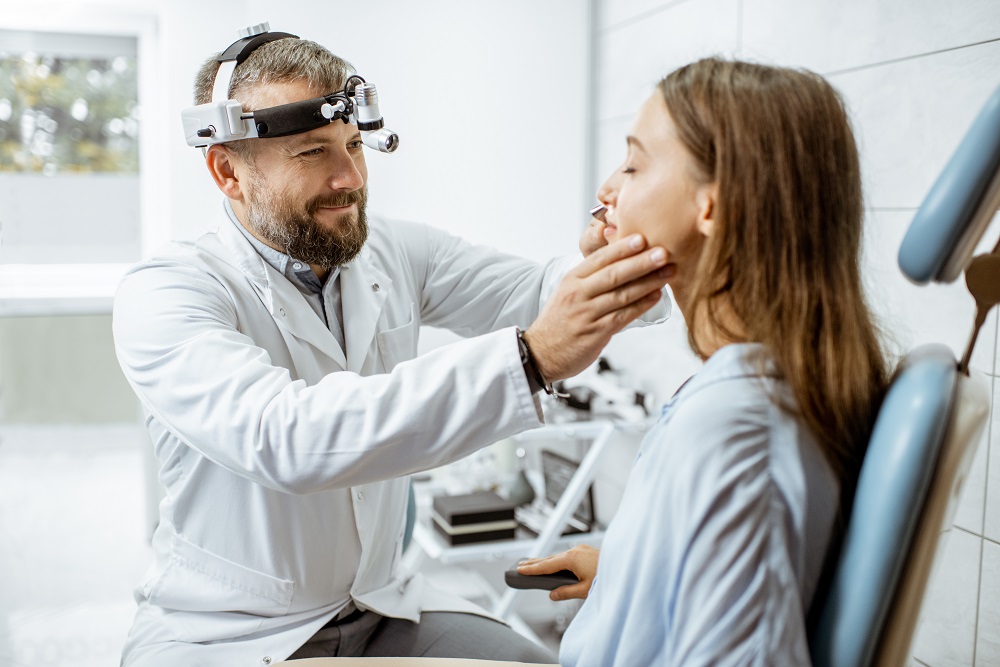


In the world of otorhinolaryngology, robotic surgery has brought about a revolutionary change in how procedures are performed. Dr. Joshua Goldberg, a renowned specialist in the field, has adopted a cutting-edge approach that harnesses the power of robotics to deliver exceptional outcomes.
With his expertise and the precision provided by robotic technology, Dr. Goldberg has pushed the boundaries of what is possible in otorhinolaryngology. By incorporating advanced robotics into his practice, he has provided patients with minimally invasive procedures, reduced pain, and faster recovery times.
This article explores the power of robotic surgery in otorhinolaryngology and highlights Dr. Joshua Goldberg’s innovative approach. We delve into the benefits of robotic-assisted procedures, the seamless integration of human skill with cutting-edge technology, and the potential for improved patient outcomes.
Join us as we uncover the progressive advancements made by Dr. Goldberg and witness how robotic surgery is revolutionizing otorhinolaryngology. Discover the remarkable potential that this innovative approach holds for patients seeking advanced surgical solutions.
Robotic surgery offers several advantages in otorhinolaryngology, making it a game-changer for surgeons and patients. One of the key benefits is the ability to perform minimally invasive procedures. With the assistance of a robotic system, surgeons can make smaller incisions, resulting in reduced trauma to the patient, minimal scarring, and quicker recovery times. Additionally, the precision and dexterity provided by the robotic arms allow surgeons to navigate complex anatomical structures, leading to improved outcomes.
Another advantage of robotic surgery is enhanced visualization. The robotic system provides a magnified, high-definition 3D view of the surgical site, allowing surgeons to see intricate details that may be difficult to observe with the naked eye. This increased visual acuity enables surgeons like Dr. Joshua Goldberg to perform more accurately and precisely.
Furthermore, robotic surgery offers improved ergonomics for surgeons. Through a console, surgeons can control the robotic arms with their hand and finger movements, translating their motions into precise movements of the robotic instruments. This ergonomic advantage reduces fatigue and enhances the surgeon’s ability to perform complex procedures over extended periods, ultimately benefiting the patient.
Dr. Joshua Goldberg is a pioneer in otorhinolaryngology and has gained recognition for his expertise in robotic surgery. With extensive training and experience, he has mastered the intricacies of robotic-assisted procedures, ensuring optimal outcomes for his patients.
Dr. Goldberg’s commitment to staying at the forefront of technological advancements in his field has allowed him to integrate robotic surgery seamlessly into his practice. By combining his clinical expertise with the precision and capabilities of robotic technology, Dr. Goldberg has elevated the standard of care in otorhinolaryngology.
Robotic surgery has proven to be highly versatile in otorhinolaryngology, with applications in various procedures. One commonly performed robotic-assisted procedure is transoral robotic surgery (TORS). This technique involves the use of a robotic system to access and remove tumors in the throat and mouth, reducing the need for traditional open surgery. TORS offers patients a shorter hospital stay, faster recovery, and improved functional outcomes.
Another area where robotic surgery has shown promise is in endoscopic sinus surgery. By utilizing robotic instruments’ precision and flexibility, surgeons can easily navigate the intricate sinus cavities, removing polyps or diseased tissue while preserving healthy structures. This precise approach improves patient outcomes, including reduced bleeding, faster recovery, and improved nasal function.
Robotic surgery has also found applications in thyroid and parathyroid surgeries. With the assistance of robotic technology, surgeons can perform precise dissections, minimizing the risk of damage to surrounding structures such as the vocal cords and nerves. This level of precision translates into better postoperative voice quality and reduced complications.
Dr. Joshua Goldberg’s innovative approach to robotic surgery has yielded remarkable success stories. One such case is that of Emily, a 45-year-old patient who was diagnosed with a tumor in her throat. Traditional open surgery would have required a large incision and a longer recovery time. However, Dr. Goldberg utilized TORS to remove the tumor through a small incision, resulting in minimal scarring and a faster return to normal life for Emily. Today, she is cancer-free and grateful for the advanced surgical approach that Dr. Goldberg provided.
Another success story involves Michael, a 55-year-old patient suffering from chronic sinusitis. Conventional sinus surgery would have required a more invasive procedure, leading to prolonged recovery. However, Dr. Goldberg performed endoscopic sinus surgery using robotic assistance, allowing for a more precise and targeted removal of diseased tissue. Michael experienced a significant improvement in his symptoms and could resume his daily activities within a shorter timeframe.
These success stories highlight the transformative impact Dr. Goldberg’s innovative approach to robotic surgery can have on patients’ lives. Through the integration of cutting-edge technology and his surgical expertise, Dr. Goldberg continues to push the boundaries of what is possible in otorhinolaryngology.
The future of robotic surgery in otorhinolaryngology holds immense potential for further advancements. As technology evolves, we can expect even more precise and sophisticated robotic systems to be developed, enabling surgeons to perform increasingly complex procedures with enhanced outcomes.
Additionally, the integration of artificial intelligence (AI) into robotic surgery has the potential to augment surgical capabilities further. AI algorithms can analyze preoperative imaging, assist in surgical planning, and provide real-time feedback during procedures. This combination of AI and robotics has the potential to revolutionize the field of otorhinolaryngology, enabling surgeons to achieve unprecedented levels of precision and patient care.
Robotic surgery relies on a sophisticated system that consists of robotic arms, surgical instruments, and a console. The surgeon sits at the console, which provides a high-definition 3D view of the surgical site. The surgeon’s hand and finger movements are translated into precise movements of the robotic instruments, which are controlled by the robotic arms.
The robotic instruments used in surgery are designed to mimic the movements of the human hand but with enhanced precision and flexibility. These instruments can rotate 360 degrees, providing surgeons a wide range of motion and access to hard-to-reach areas. The robotic arms are also equipped with sensors that provide haptic feedback, allowing surgeons to feel the resistance encountered during surgery.
Given robotic surgery’s complexity and specialized nature, surgeons undergo extensive training and certification to ensure proficiency in this advanced surgical approach. Surgeons interested in practicing robotic surgery typically complete fellowship programs that provide focused training in robotic-assisted procedures.
Surgeons gain hands-on experience in the operating room during these fellowships, working alongside experienced robotic surgeons. They also undergo simulation-based training, which allows them to practice surgical techniques in a controlled environment. Additionally, surgeons must pass rigorous examinations to obtain certification in robotic surgery, ensuring they meet the highest standards of proficiency and safety.
While robotic surgery offers numerous advantages, it has challenges and limitations. One of the main challenges is the high cost of acquiring and maintaining robotic systems. The initial investment and ongoing maintenance and instrument costs can be significant. This cost factor may limit the accessibility of robotic surgery in certain healthcare settings.
Another limitation is the learning curve associated with robotic surgery. Surgeons must invest time and effort to become proficient in this specialized technique. The complexity of the robotic system, coupled with the need for precise hand-eye coordination, can make the learning process demanding. However, with proper training and experience, surgeons can overcome these challenges and deliver exceptional outcomes.
Additionally, robotic surgery may not be suitable for all patients and procedures. Certain anatomical variations or conditions may present challenges in using the robotic system effectively. Surgeons must carefully evaluate each patient’s case to determine the most appropriate surgical approach, weighing the benefits and limitations of robotic surgery.
The power of robotic surgery in otorhinolaryngology, as exemplified by Dr. Joshua Goldberg’s cutting-edge approach, has transformed the field. The advantages of robotic-assisted procedures, such as minimally invasive surgery, enhanced visualization, and improved ergonomics, have revolutionized patient care.
By embracing robotic surgery, patients can benefit from reduced pain, faster recovery times, and improved outcomes. With their expertise and innovative techniques, Surgeons like Dr. Goldberg continue to push the boundaries of what is possible in otorhinolaryngology.
As technology advances and AI becomes increasingly integrated into robotic surgery, we can expect even greater advancements. The future holds immense potential for further refinements in surgical techniques, enabling surgeons to deliver the highest care to their patients.
In conclusion, the power of robotic surgery in otorhinolaryngology is undeniable. The remarkable potential that this innovative approach holds for patients seeking advanced surgical solutions is a testament to the ongoing advancements made by surgeons like Dr. Joshua Goldberg. As the field continues to evolve, we can look forward to a future where robotic surgery becomes the gold standard in otorhinolaryngology, providing patients with exceptional care and improved quality of life.





